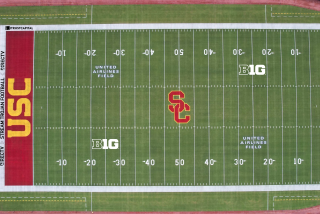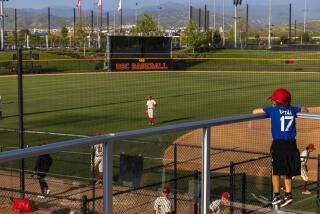Organizing the Game-Day Chaos
- Share via
Truth be told, Cynthia Wiese hasn’t played much flute recently. She stands at the back of an impromptu marching band, about 500 musicians, many of whom look a few years past marching age this chilly morning.
“I practiced a little last night,” the 34-year-old says, instrument in one hand, a beer in the other.
“Yeah,” says a flutist standing beside her. “And you were terrible.”
Apparently, the grunt work that goes into making a college football game, the details behind the pageantry, isn’t always pretty.
In the hours before USC’s homecoming game against Washington State on Saturday, Wiese and the rest of the alumni band quickly rehearse for their annual performance. Nearby, the current Trojan band practices as traffic officers funnel cars into parking lots. Television crews double-check cameras. Workers attend to last-minute glitches at the stadium.
By 9:30 a.m., the two men in charge -- John Henderson, USC assistant athletic director, and Rob Joyner, a Coliseum executive -- have already been on the job for three hours. From a drab office above the east end zone, Henderson gives instructions by cellphone: “Tell her to go to the top of the ramp. The top.”
Joyner stands across the room, pressing a walkie-talkie to his ear, frowning.
“Some Ryder truck ran into a tree.”
*
Five years ago, when USC was mediocre, homecoming ranked among the few games that drew well. Now, with the Trojans on a 30-game winning streak, it is simply another Saturday of dealing with 90,000-plus fans.
University and stadium officials employ more than 1,000 workers to staff the Coliseum. There are ushers and concession-stand attendants, yellow-jacketed security guards and 60-100 off-duty Los Angeles Police Department officers. There are groundskeepers, electricians and maintenance men.
For a game starting at 12:30 p.m., the employee shuttle starts running at 4 a.m.
“Someone has to get there to cook the hot dogs and make the coffee,” says Pat Lynch, the Coliseum’s general manager.
ABC sends a crew of 70 for the Washington State game, arriving on Thursday to lay 2,500 feet of cable and position 10 cameras.
In 1994, a blown circuit breaker at the stadium resulted in a TV blackout during a USC-Notre Dame game. ABC had to borrow a cable feed.
“Any time the picture or audio goes out, I mean, that’s the worst thing,” says Mark Loomis, the producer Saturday.
For USC’s Henderson, keeping the power on is only one concern.
Are all the tickets distributed and is everything set for the fire marshal’s walk-through? Does the band know when to play the national anthem, so TV doesn’t open its broadcast in the middle of the rockets’ red glare? And what about the yellow ropes on the field?
“They keep people at bay when Traveler comes through,” he says, referring to the Trojans’ horse. “We used to lose them every weekend, so every week I would go to Home Depot or Lowe’s to buy new ones.”
*
On Saturday, the first issue is getting fans to their seats.
The effort begins with 45-50 traffic cops at surrounding intersections five hours beforehand. They wave everyone clockwise -- all right turns -- around the area.
With about 2.5 occupants per car, a crowd of 92,000 translates into as many as 36,800 vehicles moving at 600-800 per lane per hour. Officials say that fans have learned to arrive earlier. Still, it is a barely manageable equation.
“An accident on a major thoroughfare kills our capacity,” says Aram Sahakian, a city traffic engineer. “Once it gridlocks, it takes a long time to get back to normalcy.”
Stadium gates bottleneck too. At the home opener against Arkansas, USC debuted a ticket-scanning system at Gate 28, the student entrance, and pretty much everything went wrong.
“It took us 30 minutes to get in,” Erica Brauer, 23, recalls. “People started shoving.”
Two hours before the Washington State game, off-duty police roam Exposition Park, monitoring the throngs. Henderson and Joyner visit each gate, adjusting barricades and counting ticket takers.
No detail is too small. Walking past a line of parked cars, Henderson spots a van without the correct parking pass. He chases the driver and tells him to move.
“You know,” he says, “we’re short of parking.”
*
At one point during halftime, several of the alumni musicians wander out of formation, oblivious, until a band official herds them into place. For the most part, however, the show goes well.
In the press box, Henderson doesn’t notice.
During games, he stays busy with broken seats and overflowing toilets. He must check regularly with police and fire officials at a command post along the rim of the stadium.
The crowds tend to be well-behaved, police say, especially since USC stopped selling alcohol during games.
But on Saturday, there is a problem in the tunnel connecting the field and the locker rooms, the teams jostling at halftime.
In the stands, officials find themselves dealing with more medical emergencies than usual. Fans are slipping and hurting themselves. They are feeling the effects of an unseasonably warm day. A man faints in the aisle above Tunnel 22.
With people flooding down to the concession stands, paramedics must push against the flow and Henderson is on his walkie-talkie again.
“Can you get a couple of ushers and set up a perimeter?” he asks. “We need to keep that area clear.”
Minutes pass and he grows impatient, heading outside to the trouble spot. Medical personnel finally reach the man, finding him conscious and alert. Still, they carry him outside to an ambulance.
By the start of the third quarter, Henderson has returned to the press box, looking a bit haggard. It’s almost the third quarter, almost time for another long walk.
Soon, with USC well on its way to a 55-13 victory, fans will grow bored. He needs to start moving barricades and adjusting signs, directing fans out of the stadium and back to their cars.
More to Read
Fight on! Are you a true Trojans fan?
Get our Times of Troy newsletter for USC insights, news and much more.
You may occasionally receive promotional content from the Los Angeles Times.







